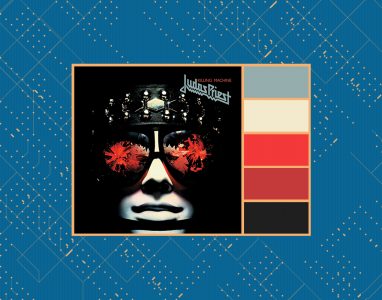Thursday Throwback is a weekly colour scheme inspired by an iconic album cover of yesteryear. This week’s throwback is the 1978 album “Killing Machine” by Judas Priest. The colours are as follows:
| Colours | HEX | RGB | HSB | CMYK | LAB |
|---|---|---|---|---|---|
| Colour 1 | #8DA6A6 | 141, 166, 166 | 180, 15, 65 | 15, 0, 0, 34 | 66, -8, -2 |
| Colour 2 | #F2E8C9 | 242, 232, 201 | 45, 17, 95 | 0, 4, 16, 5 | 92, -1, 16 |
| Colour 3 | # F22929 | 242, 41, 41 | 0, 83, 95 | 0, 83, 83, 5 | 52, 72, 51 |
| Colour 4 | # BF2A2A | 191, 42, 42 | 0, 78, 75 | 0, 78, 78, 25 | 42, 57, 37 |
| Colour 5 | #0D0D0D | 13, 13, 13 | 0, 0, 5 | 0, 0, 0, 94 | 3, 0, 0 |
“Killing Machine” is the fifth studio album by the English heavy metal band Judas Priest, released in November 1978 through CBS Records. The album was recorded at Utopia and CBS Studios in London in August 1978 and produced by James Guthrie alongside the band members. This release marked a significant shift in sound and image for Judas Priest.
At this pivotal moment, the band aimed to adopt a more accessible, commercial style while retaining their heavy metal roots. This evolution was partly influenced by the rising punk and new wave movements, as well as a desire to appeal more to American audiences. The album’s sound blends traditional heavy metal with radio-friendly elements, resulting in a refined production compared to earlier works.
The inspirations for “Killing Machine” were varied; tracks like “Burnin’ Up” and “Evil Fantasies” delve into S&M themes, while “Running Wild” captures late-night partying vibes. The melancholic ballad “Before the Dawn” highlights their versatility, whereas “Hell Bent for Leather” reflects their iconic leather-clad image.
The cover art was designed by Rosław Szaybo, then art director for CBS Records. Known for creating several iconic album covers for high profile artists such as Elton John, Janis Joplin and Santana, Szaybo also designed the cover for the band’s previous album Stained Class as well as the band logo. He later went on to design the covers for subsequent Judas Priest albums British Steel and Sin After Sin. In the US the album was released under the title “Hell Bent for Leather,” though its cover remained unchanged.
Upon release, “Killing Machine” received mixed reviews but is generally considered successful despite modest chart positions—barely reaching UK Top 40 and number 128 on US Billboard 200. It paved the way for future commercial triumphs of Judas Priest’s career; notably with singles like “Take On The World” reaching number 14 on UK charts.
In later years, it was recognized as significant within both their discography and broader heavy metal history—it ranked number 321 in Rock Hard magazine’s book “The 500 Greatest Rock & Metal Albums of All Time.” Its influence helped make heavy metal more mainstream accessible, setting the stage for future blockbuster releases that contributed to the evolution of the genre’s sound, bridging the gap between complex styles and commercially viable ’80s era bands that followed suit using hard-hitting riffs, catchy melodies, and a polished production template for success thereafter.
“Killing Machine” represents a crucial turning point showcasing the transition from cult act to mainstream stars.
Did you like this week’s colour scheme? Do you fancy using it for your next release cover? Visit our shop or drop us a line!

